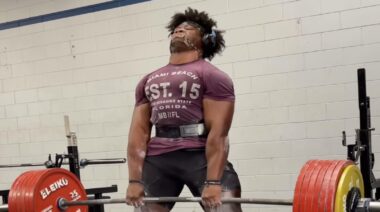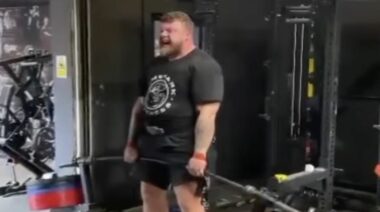The Deadlift. The greatest test of strength. It’s you versus the loaded barbell. A one-on-one battle to pry the bar from the floor, to conquer it, to lift it. The deadlift is my favorite lift to perform and to coach.
The deadlift sounds simple, right? You bend over, you grip the bar, and you lift it up. But I cringe more often than I applaud deadlifts both on the Internet and at competitions. I see countless lifters perform the deadlift with the ticking time-bomb of a herniated disc due to their bad technical approach.
Me performing a max weight deadlift at a recent King of the Deadlifts competition
This article covers three common flaws I see in lifting approach, set up, and deadlift technique. These errors are holding back your progress and keeping plates off the bar. I’ll give you cures for each one – not only to improve how much you lift, but also how safely you are doing it.
Flaw #1 – You’re Standing Too Far Away
If you’re failing lifts at your knees and it feels like you’re getting pulled forward, take a look down before you grip the bar. How close are your shins to the bar?
If there is a big gap between your shins and the bar before you initiate the lift, you are placing yourself at a biomechanical disadvantage. The bar isn’t over your center of mass and therefore becomes heavier. Hold a twenty-kilo plate on your chest, then hold it at arm’s length. It feels heavier at distance from the body, right? So why do that with your deadlift?
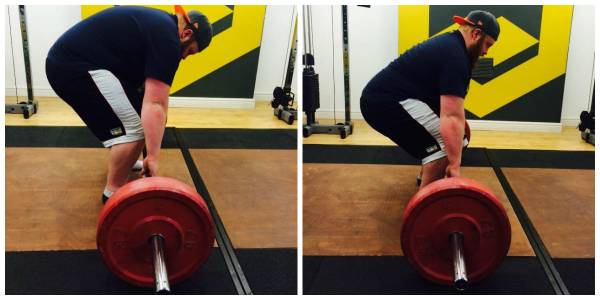
Left: Wrong – bar away from shins; Right: Correct – bar close to the body
If the problem is you can’t get your shins close to the bar, the likely culprit is your ankle mobility. This is a common reason for failed lifts as it causes:
- The weight to pull you forward onto your toes.
- Failure to get your glutes involved.
- Failure to get your hips through.
Cure – Stretch Out the Tibialis Anterior
I’ve talked about this little beauty of a muscle before, and its relationship with a stronger squat. It’s relevant to your deadlift, too. You need to be able to move your ankle through a movement called dorsiflexion (where your shins move toward your toes).
The tibialis anterior muscle runs down the side of the shin and attaches to the first metatarsal of the foot. It’s a key player in controlling dorsiflexion and often gets tight, which reduces your range on both squats and deadlifts. Most people think of their shin as just a piece of bone. Yet this thin little muscle that runs alongside the shin gets tight, gets shortened, and then reduces your ability to move.
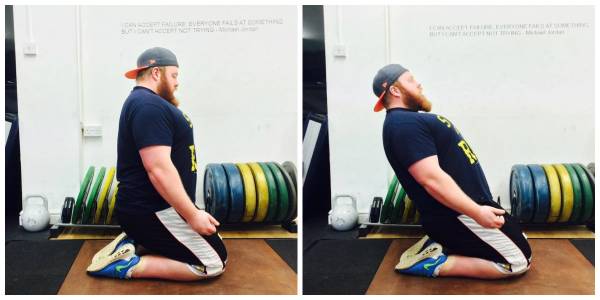
Left: Kneel on the floor with your feet and toes flat to the floor. Right: Lean back to sit back on your heels.
The stretch is simple. Kneel on the floor with your feet and toes flat to the floor. Lean back to sit back on your heels, and then lean further back. You will feel a stretch through your ankles and shins. Hold for ten seconds, then sit back forward. Repeat three times, jump back up, and notice the difference.
Flaw #2 – You Have No Tension Through Your Upper Back
Some powerlifters advocate minimal tension in your upper back and shoulders as it allows you to reduce the range of movement on your lift, shortening your lockout substantially. This is true, and a useful tool for seriously advanced lifters. However, for most, this lack of tension promotes a severely rounded lumbar and thoracic spine before the bar is even lifted. This is sloppy spinal positioning and a serious injury risk.
“If your back is severely rounded, you’re at a biomechanical disadvantage and are not properly involving your legs in the lift.”
You should be using your lats and upper back to stabilize, support, and stack the spine the way it was designed. This will ensure you’re not on a one-way trip to a medical room for a herniated disc. I’m not talking about just contracting your shoulder blades together. I’m talking about creating a stiff and rigid upper back that supports your spine. Champion powerlifter Andy Bolton calls this a “lat lock,” which describes it well.
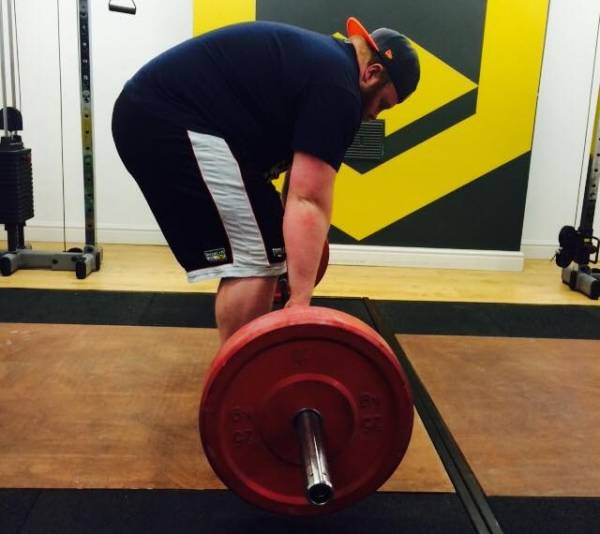
Don’t take a rounded upper back to extremes.
If your back is severely rounded, you’re at a biomechanical disadvantage and are not properly involving your legs in the lift. Consider the weight-moving potential of your quads, hamstrings, and glutes, along with their combined muscle mass. With your back rounded and not engaged from the start of the lift, you take away all of that leg strength, and rely purely on what your lower back can do.
Cure – Squeeze the Hell Out of the Bar, Lock Your Lats
Try this: squeeze your lats and engage your rhomboids. Done? Okay, rest and remember what that feels like.
“You should be using your lats and upper back to stabilise, support, and stack the spine the way it was designed.”
Now, make a fist. Not just a weak fist, but a white-knuckle-trying-to-crush-a-granite-block-type fist. Seriously squeeze your hand. Now squeeze your lats and engage your rhomboids. Feel the difference? It’s noticeable. If you just hold the bar or apply a small amount of pressure to your lifting straps, you remove a huge chance to engage your upper body, create a stable and locked trunk, and bag yourself a stronger deadlift.
This cure is quite simple – when you address the bar, squeeze the hell out of it, tighten up your lats, and feel your rhomboids engaging.
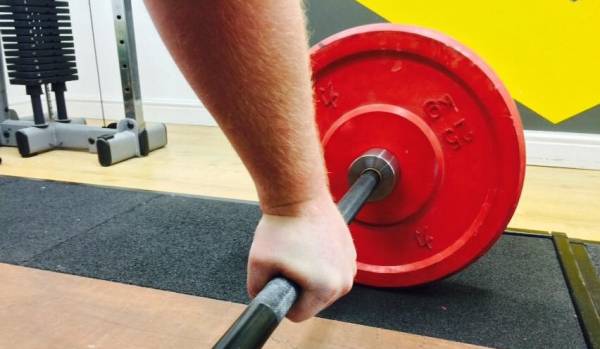
Squeeze the hell out of the bar.
Flaw #3 – You’re Not Taking the Tension Out of the Bar
“Grip and Rip.” If you own a t-shirt with this written on it, please burn it immediately to remind yourself to never yank on the bar. All bars will flex and bend as you apply tension to them, whether you’re dealing with an expensive deadlift-specific bar or a common gym bar with no discernible knurling. This means if you don’t take the tension out of the bar, the bar ends up working against you. And on top of this, you won’t be creating maximal tension in your body.
If you just aimlessly rip the bar off the ground, you will be half way through your movement before the bar moves. All you will have done is take the flex out of the bar. With the flex then catching up, the bar will start to move, but by this point your hips are high, your shoulders are over the bar, and the rep becomes a grinder.
By not creating tension in your body, you’ve also lost a lot of potential to exert maximal force upon your lift. Try this: place the tip of your index finger against the tip of your thumb, and exert maximal force with your finger as if you were trying to flick something. Quickly move your thumb away and notice the speed at which your finger travels.
“If you just aimlessly rip the bar off the ground, you will be half way through your movement before the bar moves.”
Now, repeat the movement but without the use of your thumb. Extend your finger as fast as you can without the use of preloading. Notice how much slower it is? The time of finger extension is less than one second. As it is so short, you can’t apply maximal force, and as a result, your finger extension becomes slower without preloading by creating tension.
This can apply in the same way to a deadlift if you aren’t using the bar to create tension in your body. A fast and strong pull can be as quick as one second, too. If you aren’t preloading your muscles for maximal power output, you’re missing a trick (and also a lot of power).
Cure – Create Tension and Take Tension
Once you’ve applied the first two cures, you’re in a better biomechanical position and you’ve created upper body tension. Time to complete the process through the rest of the body. You must prepare to release the accumulated tension as maximal force production during the pull.
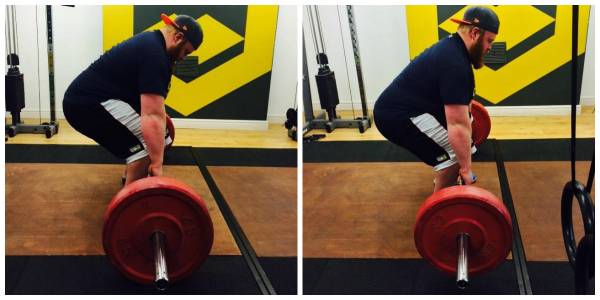
Left: Take the tension; Right: Drive through the floor.
You need to load your glutes, hamstrings, and quads; ready for the pull; and take the flex out of the bar. The easiest way to achieve this is to push your hips into the bar before you pull. As you actively grip the bar, try to contract your glutes to push the hips in toward the barbell. You will see the barbell flex and feel your entire lower body engage and get ready to unload the accumulated tension.
Summary
Now, with your better biomechanical position, engaged torso, and lower body tension, you’re set to lift. Take the flex out of the bar, drive the heels into the floor hard, and push the ground away from you. Your hips won’t shoot up, your back won’t dangerously round and sag, and you will have a powerful lockout. And the bar will move faster than you have ever experienced.
- 3 Reasons You Don’t Squat More (And What to Do About It)
- 15 Practical Strategies to Increase Your Deadlift Max
- The 25 Rules of Strength Training (Part 2)
- What’s New on Breaking Muscle Today


